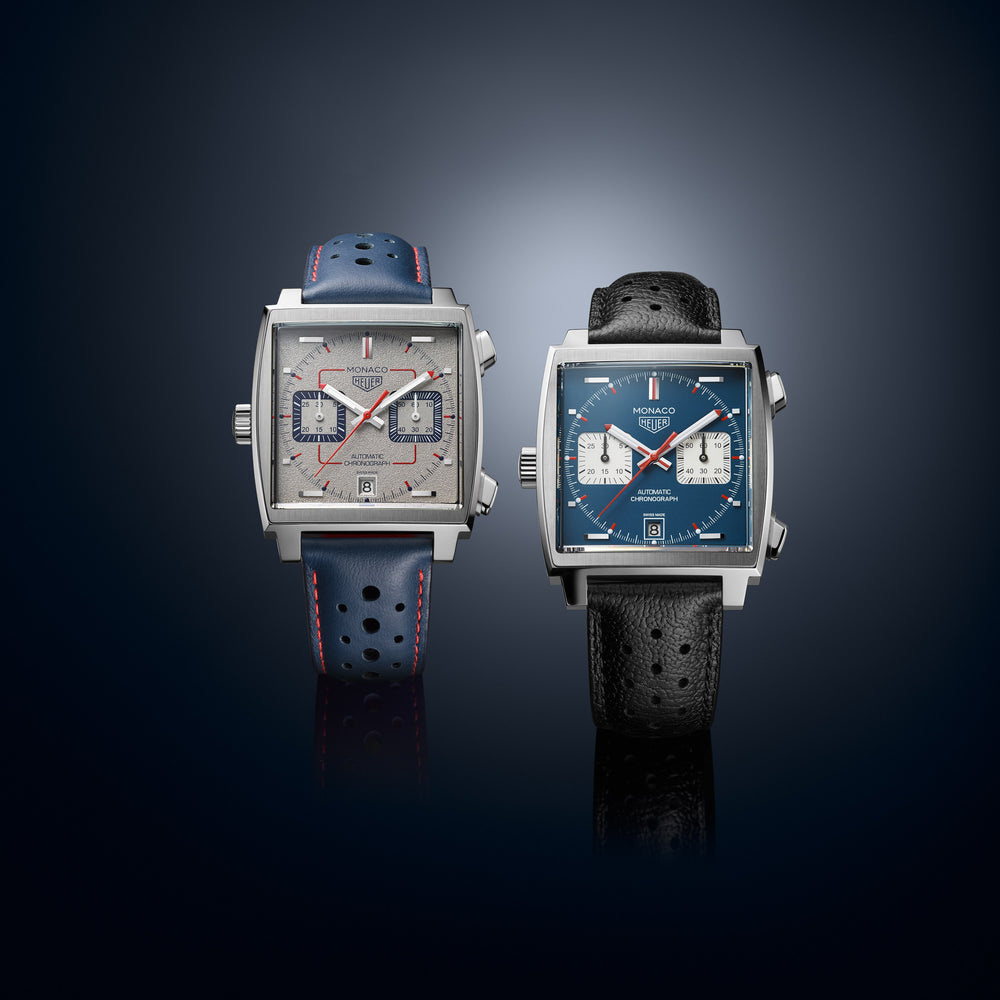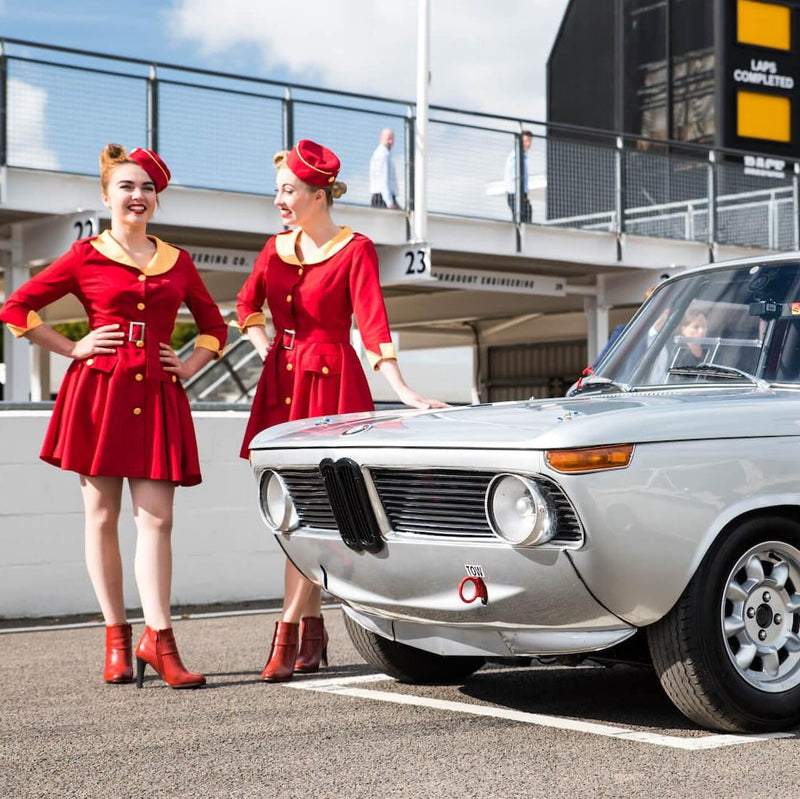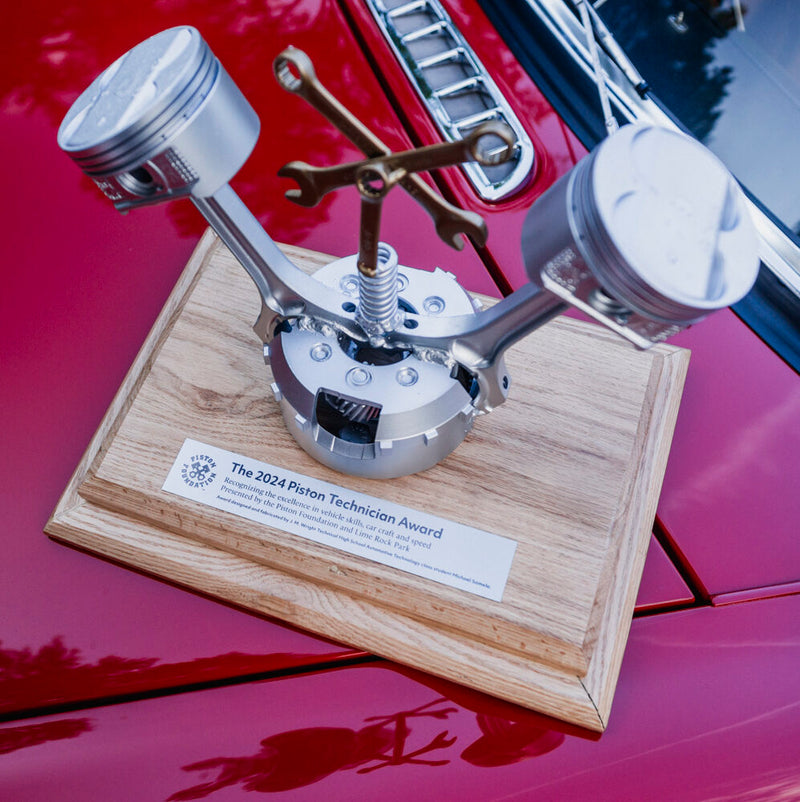Photography by Kieran Buttrick and courtesy ofTAG Heuer
A compelling case can be made that no Swiss watch manufacturer is more closely associated with motorsport than TAG Heuer, and that there is no Swiss watch more closely associated with racing drivers than the TAG Heuer Monaco.
Although initially marketed to be the “racing enthusiast’s” model (the Autavia was presented as the “driver’s choice”), the square silhouette of the Monaco chronograph has been burnt into the fabric of racing iconography and is perhaps the most widely identifiable bit of wristwear at racetracks and club gatherings the world over. This year, TAG Heuer (née Heuer) is celebrating 50 years of the Monaco and is releasing a selection of five limited edition models to commemorate each decade of production throughout the 50th anniversary year.






I attended the launch of the fourth model—1989-1999—in this year’s series in New York City recently, which paid a lighthearted tribute to the 1990s. On hand were driver/actor Patrick Dempsey and two-time Formula E World Champion Jean-Éric Vergne. I sat down with them to discuss their respective careers in motorsport and their appreciation for wristwatches.
The following conversation has been condensed and edited for clarity
James Lamdin: I'm curious about when your interest in motorsport began, and when and how you transitioned into professional driving. Can you tell me a little about that?
Patrick Dempsey: Since I was a kid, my father would always bring me Matchbox cars on Friday nights. And he actually owned a short track team in Maryland. So I grew up with his passion, and that sort of affected me, but I didn't start getting into it until my late 30s. My wife got tired of me sitting on the couch and watching races so she gave me a Skip Barber three-day competition certificate for Laguna Seca. And that's how it started. And then it all changed. That was that, the addiction began.
J.L.: And Jean-Éric, you were you're about 10 when you started racing?
Jean-Éric Vergne: Younger! I was born on the karting track. I think I was driving the karts on my father’s knee before I could even walk.
J.L.: Patrick, I understand you've also done some acting? There are a number of actors who have made the move from screen to track, like the one on that poster over there . Did any of them inspire you, or was that totally unrelated to your journey?



P.D.: Paul Newman did. I got a chance to meet him at Long Beach and he was legitimately really quick. And he did everything. He did the Baja, he did Le Mans once and got on the podium. Won in his class in the wet. He raced at the Rolex 24—all over, a really talented driver.
And then McQueen was too—he raced at Sebring with a broken leg and got on the podium. In a car that was really quite challenging. Sebring is a really tough circuit, one of the toughest.
J.L.: In recent years, you’ve made the transition to team ownership and management. Can you talk a little bit about that? And do you miss being behind the wheel?
P.D.: It's always hard to go to a race and not be in the car. But once I made a decision to get out and not do any more endurance racing, I was okay. Now it's a little bit harder though. I found it much harder this year after the 24 Hours of Le Mans. I had to do some sprint races, because I missed the people. I missed the camaraderie. To me, that was the attraction.
J.L.: You mean with the other drivers?
P.D.: Yeah, I mean, you're really aggressive on the track, but after there's a bonding that you have with your fellow drivers that's really quite special, and that’s what I value the most.
J.L.: You clearly have a passion for Porsche. I'm curious to know what some of your favorites are, as well as how you decided to ultimately race with them.
P.D.: My first big project was a movie called Can’t Buy Me Love, and I spent that entire paycheck on a Porsche. It was a 1963 356. And I still have that car today. That was like a turning point for me when I got that car.



J.L.: Once you experienced that 356, did it inspire you to ultimately want to race the marque?
P.D.: Yes, but I knew I had to really work before I could get to that point. Mazda was really supportive to me very early on, they finally won in the prototype at Watkins Glen. Really happy for Jim Doonan and that whole program. And then by that time I had enough experience to get to Porsche, and then to get to Le Mans to be able to drive.
I think the biggest challenge with Le Mans is the mental aspect of it in managing traffic. I think the pressure there physically, it's different.
J.L.: As a team owner and manager, how has your experience from the driver’s side influenced your approach?
P.D.: The program now is really developing the younger drivers and giving them an opportunity to move up and I'm really enjoying that effort.
J.L.: Jean-Éric, who were your motorsports heroes as you were coming up in your racing career?
J.-É.V.: Probably all French and Italian kart racers you’ve never heard of! My father always told me not to dream of Formula One because you're never gonna make it. There are only 20 drivers in the world, a new one coming every few years at most. So it was not even a dream.

J.L.: I guess you proved him wrong! Can you speak to the difference in driving dynamics moving from internal combustion cars into electric powertrains, in Formula One and Formula E, respectively?
J.-É.V.: The driving is very different. You have a lot of torque with the electric cars, the delivery is instant which is not the case in the petrol cars. And then the racing is also completely different because we are only racing in street circuits in big cities like New York, Paris, Hong Kong, Rome, and others, which Formula One doesn’t have access to. For example, next year we're doing the final in London. Bernie Ecclestone tried I don’t know how many times to go into London to have a Formula One race but never succeeded. And we come in with Formula E and because it's electric it's kind of welcomed because it’s the hot topic of today.
J.L.: Certainly. Jean-Éric, I’ve also heard that both you and Patrick are more than casual wristwatch enthusiasts, when did you two start on that path?
P.D.: Well I think it goes hand in hand with any kind of sport, but certainly with motorsports.
J.-É.V.: Well, we’re men. We like three things in life.
P.D.: And car racing and watches are those two things.
J.-É.V. and J.L.:
P.D.: A watch is a piece of jewelry that has purpose, and it's a conversation piece for people.
J.L.: I read an interview you did with my friend Frank when you were at Monaco for the Formula 1 GP and you're wearing a great vintage Heuer Monaco. Are there any other favorites from TAG Heuer’s collection, past or present?



P.D.: I also have a “Jo Siffert Autavia” from ’69, but I don’t have a Carrera, that's another one I need to get, then I’ll have the trifecta. The value of their vintage watches keeps going up.
J.L.: How about watches for you, Jean-Éric? How did that evolve?
J.-É.V.: So my dad can give me a vintage Rolex from my birth year, 1990, when I was 18. And this is when I first had a very nice watch to wear. I loved it. So I started my own collection.
I started to have many different watches since then, and Heuer and TAG Heuer have always been an iconic sponsor in my sport, in my world. I think of Senna, obviously that's my reference when it comes to motorsports, and his cars often had TAG Heuer on them. So it's something that makes complete sense to me, to like this brand. So when this year I had the opportunity to become the ambassador for TAG Heuer in Formula E, it was a no-brainer. I was joining an iconic brand that had sponsored the best sportsmen ever to me, like Senna, and in a way I was trying to follow a little bit of his path in my world.

J.L.: Patrick, you've been working on several racing films, which I think everyone in the car community is very excited about—could you talk a little about those?
P.D.: Yes, we have Hurley, which is the documentary about Hurley Haywood with which is really, I think, an important story. And for him to open up and to talk about his life and his journey is very important.
And also The Art of Racing in the Rain, just to expose more people to the sport, people that normally wouldn't look at it. I hope that we're bringing new people into the sport.
J.L.: Is there any chance we're going to see some vintage Heuers in some of these films, or maybe a portrayal of Jack Heuer himself?
P.D.: Well, I did the short film Letter To Jack which was fun to make. And to me that was very special. For me, that's the best part of this relationship is having time with Jack Heuer.


J.L.: I can imagine. Jack Heuer is probably the most interesting man I’ve ever met. Getting back to motorsport though, I wanted to ask, Jean-Éric, is there anything you miss about racing internal combustion cars?
J.-É.V.: Well I still race them actually. I still race in LMP2, prototype race cars with 600 horsepower, and I love it, but it's completely different from Formula E.
My favorite race is the 24 Hours of Le Mans, it’s something I absolutely love. And you know, as much as Patrick said, the whole atmosphere during the week of the 24 Hours is just amazing, and you don't get that in any other championship or anywhere else in car racing. Maybe the Indy 500, which I have never done. Hopefully I will one day.
P.D.: You want to do the 500?
J.-É.V.: A hundred percent.
J.L.: Jean-Éric, are there any memorable highlights in your racing career so far that really stand out to you? Aside from being the Formula E World Champion of course.
J.-É.V.: Yeah, when I when I was 20, in 2010, when I was racing in the British Formula Three Championship. It was probably one of the best years. I had so many races all across England and it was the first time I'd moved away from my home and from my family. I went to live in Milton Keynes, which was a horrible city in many measures, but still, I loved it. It was amazing, and it was the where everything started to kick off for me and when the hope of one day going to Formula One came very close to my reality.
J.L.: Do you think that electric technology is still going strong, or stagnating?
J.-É.V.: Still going! I believe that electric technology is not close to the end of its development, I believe there is still alternative energy sources coming around, like hydrogen, but is not quite ready at the moment. But the electric technology gives us the electric powertrain that can be used with hydrogen, any other source of power, and it is the way all the manufacturers are going now. I don't know how many billions the big German manufacturers have spent on electric technology, but I doubt it’s slowing down. That's the main reason why we get 10 manufacturers in the championship, whereas Formula One has just three or four.
J.L.: As a parting question for both of you, could you share any words of inspiration with the Petrolicious community or car enthusiasts in general who might be toiling away at a desk and want to become racing drivers?
P.D.: Go karting! Karting is the best bang for your buck. It gets you started.
J.-É.V.: Agreed, completely.
Click here for more information on the TAG Heuer Monaco 1989-1999 Limited Edition





















































